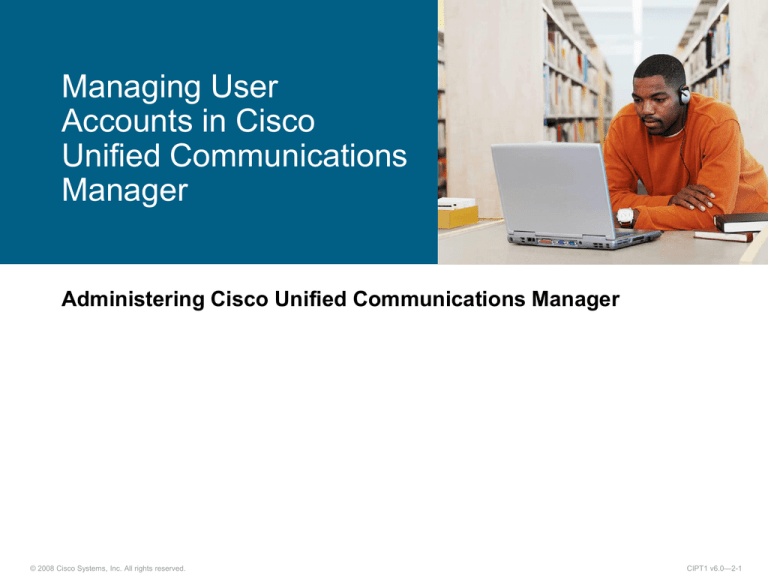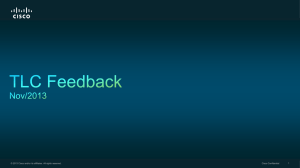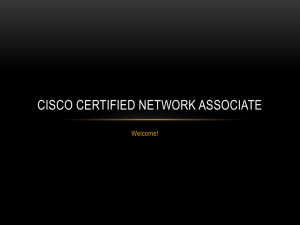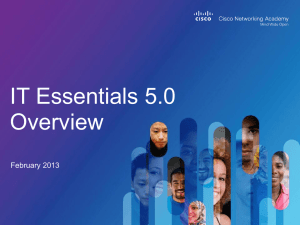
Managing User
Accounts in Cisco
Unified Communications
Manager
Administering Cisco Unified Communications Manager
© 2008 Cisco Systems, Inc. All rights reserved.
CIPT1 v6.0—2-1
Outline
Cisco Unified Communications Manager User Accounts
Managing User Accounts Using the Administration GUI
Cisco Unified Communications Manager BAT
Managing User Accounts Using the Cisco Unified
Communications Manager BAT
LDAP
Using LDAP for User Provisioning
Using LDAP for User Authentication
© 2008 Cisco Systems, Inc. All rights reserved.
CIPT1 v6.0—2-2
Cisco Unified Communications Manager
User Accounts
© 2008 Cisco Systems, Inc. All rights reserved.
CIPT1 v6.0—2-3
Cisco Unified Communications Manager
Features Interacting with User Accounts
Cisco Unified CM user and administrator web interfaces
– Cisco Unified CM User web pages
– Cisco Unified CM Administration
– Cisco Unified CM Serviceability
– Cisco Unified CM operating system Administration
– Cisco Unified CM Disaster Recovery System
Cisco Unified CM applications
– Cisco Unified CM Attendant Console
– Cisco Unified CM Extension Mobility
– Cisco Unified CM Assistant
Directories
Cisco IP Phone Services
© 2008 Cisco Systems, Inc. All rights reserved.
CIPT1 v6.0—2-4
Two Types of User Accounts in Cisco
Unified Communications Manager
End Users
Application Users
Associated with an individual person
Associated with an application
For personal use in interactive logins
For non-interactive logins
Used for user features and individual
administrator logins
Used for application authorization
Included in user directory
Not included in user directory
Can be provisioned and authenticated
using an external directory service
(LDAP)
Cannot use LDAP
© 2008 Cisco Systems, Inc. All rights reserved.
CIPT1 v6.0—2-5
Data Associated with User Accounts
Personal and organizational settings
– User ID, First Name, Middle Name and Last Name
– Manager User ID, Department
– Phone Number, Mail ID
Password
Cisco Unified CM configuration settings
– PIN and SIP digest credentials
– User privileges (user groups and roles)
– Associated PCs, controlled devices, and directory numbers
– Application and feature parameters (Extension Mobility profile,
Presence Group, Mobility, CAPF, etc.)
© 2008 Cisco Systems, Inc. All rights reserved.
CIPT1 v6.0—2-6
User Privileges
Privileges are assigned to application users and end users.
Privileges include these accesses:
– Access to user web pages.
– Access to administration web pages.
Access to specific administration functions.
– Access to APIs (CTI, SOAP, etc.)
User privileges include these configuration elements:
– User groups (a list of application and end users).
– Roles (a collection of resources for an application).
Each role refers to one application.
Each application has one or more resources (static list).
Per role, access privileges are configured per application resource.
– Roles are assigned to user groups.
© 2008 Cisco Systems, Inc. All rights reserved.
CIPT1 v6.0—2-7
User Privilege Component Interaction
Users
n:n
User Groups
n:n
Roles
n:1
Applications
1 : 1 Privileges
Application1
User1
Role1
User2
Group1
Role2
User3
Group2
Role3
Resource1
read
Resource2
(none)
Resource3
read, update
Application1
Resource1
read, update
Resource2
read
Resource3
(none)
User4
Application2
© 2008 Cisco Systems, Inc. All rights reserved.
Resource1
read
Resource2
read
Resource3
(none)
Resource4
read, update
CIPT1 v6.0—2-8
Roles and User Groups Example
User Group
Standard CCM Super
Users
• User “John Doe”
• User “Jane Smith”
Standard CCM ReadOnly
• User “Kim Lu”
• User “Tom Adams”
Role
Standard
CCMADMIN
Administration
Standard
CCMADMIN
Read-Only
Application
Resource
• Call Park web
pages
• AAR Group
web pages
• Cisco Unified
CM Group
Cisco Unified CM web pages
Administration • DRF Show
Status Page
• …
Cisco Unified CM
Administration
Privilege
Update
Read-Only
Goal: Have administrators with full access and administrators with
read-only access to Cisco Unified Communications Manager
Administration
Solution: Two user groups and two roles
© 2008 Cisco Systems, Inc. All rights reserved.
CIPT1 v6.0—2-9
User Management Options
One-by-one manual configuration using Cisco Unified
Communications Manager Administration
Bulk configuration using Cisco Unified Communications
Manager BAT
LDAP integration (for end users only):
LDAP synchronization
– For user provisioning
– Personal and organizational user data are managed in
LDAP
LDAP authentication
– For user authentication
– Passwords managed in LDAP
© 2008 Cisco Systems, Inc. All rights reserved.
CIPT1 v6.0—2-10
LDAP
Specialized database stores information about users
– Centralized storage of user information
– Available to all enterprise applications
LDAPv3 – Lightweight Directory Access Protocol version 3
Examples
– Microsoft Active Directory, Netscape, iPlanet, SunONE
Cisco Unified CM supports two types of integration
– LDAP synchronization
– LDAP authentication
When using LDAP, some user data are no longer controlled via
Cisco Unified Communications Manager Administration
© 2008 Cisco Systems, Inc. All rights reserved.
CIPT1 v6.0—2-11
Cisco Unified CM End-User Data
Location
No LDAP
LDAP
LDAP
Integration Synchronization Authentication
Personal and organizational
settings:
LDAP
(replicated
to local)
LDAP
(replicated
to local)
User ID
First, Middle, and Last Name
Manager User ID and Department
Phone Number and Mail ID
Local
Password
Local
Local
LDAP
Local
Local
Local
or
Local
Cisco Unified CM Settings:
PIN and Digest Credentials
Groups and Roles
Associated PCs
Controlled Devices
Extension Mobility Profile and
CAPF Presence Group and Mobility
© 2008 Cisco Systems, Inc. All rights reserved.
CIPT1 v6.0—2-12
Managing User Accounts Using
the Administration GUI
© 2008 Cisco Systems, Inc. All rights reserved.
CIPT1 v6.0—2-13
User Management Using Unified
Communications Manager Administration
Performed from Unified CM
Administration > User
Management
– Requires sufficient privileges
Use master administrator
account created during
installation.
Use end-user account with
user management privilege.
Available options include
– Application User
– End User
– Role
– User Group
© 2008 Cisco Systems, Inc. All rights reserved.
CIPT1 v6.0—2-14
Application User Configuration Page
Set user ID and
password.
© 2008 Cisco Systems, Inc. All rights reserved.
CIPT1 v6.0—2-15
Application User Configuration Page (Cont.)
Add application user
to user groups.
View roles of
application user.
© 2008 Cisco Systems, Inc. All rights reserved.
CIPT1 v6.0—2-16
End User Configuration Page
© 2008 Cisco Systems, Inc. All rights reserved.
CIPT1 v6.0—2-17
Roles
Standard (default) roles exist; standard roles cannot be deleted.
Custom roles can be created by adding new roles or by copying
and then modifying standard roles.
© 2008 Cisco Systems, Inc. All rights reserved.
CIPT1 v6.0—2-18
Role Configuration Page
Selected application
Configured privilege
per application
resource
Roles are configured per application and consist of application resource
privileges.
© 2008 Cisco Systems, Inc. All rights reserved.
CIPT1 v6.0—2-19
User Groups
Standard (default) user groups exist; standard user groups cannot be
deleted.
Custom user groups can be created by adding new roles or by copying
and then modifying standard roles.
© 2008 Cisco Systems, Inc. All rights reserved.
CIPT1 v6.0—2-20
User Group Configuration Page: User
Assignment
End users and application users are added to user groups.
© 2008 Cisco Systems, Inc. All rights reserved.
CIPT1 v6.0—2-21
User Group Configuration Page: Role
Assignment
User Group >
Related Links:
Assign Role to User
Group
© 2008 Cisco Systems, Inc. All rights reserved.
CIPT1 v6.0—2-22
Cisco Unified Communications
Manager BAT
© 2008 Cisco Systems, Inc. All rights reserved.
CIPT1 v6.0—2-23
Cisco Unified Communications
Manager BAT
Cisco Unified Communication Manager BAT allows
management of many devices and records within a short
period of time.
© 2008 Cisco Systems, Inc. All rights reserved.
CIPT1 v6.0—2-24
Cisco Unified Communications Manager
BAT Characteristics
Performs bulk transactions to the Cisco Unified Communications
Manager database.
Adds, updates, or deletes a large number of similar phones,
users, or ports at the same time.
Exports data (phones, users, gateways, etc.).
– Exported files can be modified and re-imported.
Integrated with the Cisco Unified Communications Manager
Administration pages and available by default (no plug-in
required).
Supports localization.
Cisco Unified CM Autoregister Phone Tool (formerly TAPS) is also
available from the Bulk Administration menu but requires
additional products.
© 2008 Cisco Systems, Inc. All rights reserved.
CIPT1 v6.0—2-25
Bulk Administration Menu
Manage
configuration files.
Manage devices
and features.
Manage TAPS
service.
Schedule
configuration.
© 2008 Cisco Systems, Inc. All rights reserved.
CIPT1 v6.0—2-26
Cisco Unified Communications Manager
BAT Components
Cisco Unified Communications Manager BAT
administration consists of these features:
Cisco Unified CM BAT templates are used to define general
settings that fit all of the devices that should be added.
CSV files are used to define devices and record specific settings
that should be bulk-configured.
Adding, updating, and deleting devices and records is done
automatically based on queries and CSV files.
Additions, updates, and deletions can be scheduled to be
performed at a defined time.
© 2008 Cisco Systems, Inc. All rights reserved.
CIPT1 v6.0—2-27
Bulk Provisioning Service
Bulk Provisioning Service (BPS) administers and maintains all
jobs that are submitted through Cisco Unified CM BAT.
BPS is listed under database services in the service activation
pages.
Service should be activated for scheduled jobs to be executed.
BPS has to be activated only on the Cisco Unified
Communications Manager publisher.
© 2008 Cisco Systems, Inc. All rights reserved.
CIPT1 v6.0—2-28
Bulk Provisioning Service (Cont.)
Activate BPS.
© 2008 Cisco Systems, Inc. All rights reserved.
CIPT1 v6.0—2-29
Managing User Accounts Using the Cisco
Unified Communications Manager BAT
© 2008 Cisco Systems, Inc. All rights reserved.
CIPT1 v6.0—2-30
Cisco Unified Communications Manager
BAT Configuration Process
The Cisco Unified Communications Manager BAT
configuration procedure includes these steps:
Step 1: Configure Cisco Unified CM BAT user template.
Step 2: Create the CSV data input file.
Step 3: Upload the CSV data input file.
Step 4: Start Cisco Unified CM BAT job to add users.
Step 5: Verify status of Cisco Unified CM BAT job.
© 2008 Cisco Systems, Inc. All rights reserved.
CIPT1 v6.0—2-31
Step 1: Configuring Cisco Unified CM
BAT User Template
Enter the user
template name.
Configure default
user parameters.
© 2008 Cisco Systems, Inc. All rights reserved.
CIPT1 v6.0—2-32
Step 2: Creating the CSV Data Input File
Cisco provides a template to create CSV files that have the
mandatory format to work with Cisco Unified CM BAT:
The template is a Microsoft Excel spreadsheet that uses macros.
The template can be personalized for specific needs.
The file can also be created using a text editor, such as Microsoft
Notepad:
– Use a separate line to enter data for each record.
– Separate each data field with a comma and include comma
separators for blank fields.
– Do not enter blank lines, otherwise errors occur during the insert
transaction.
© 2008 Cisco Systems, Inc. All rights reserved.
CIPT1 v6.0—2-33
Step 3: Uploading CSV Data Input File
a) Select the
user data file.
b) Select target.
c) Select activity
type.
d) Start file
upload.
© 2008 Cisco Systems, Inc. All rights reserved.
CIPT1 v6.0—2-34
Step 4: Starting Cisco Unified CM BAT
Job to Add Users
a) Select the
user data file.
b) Select the
template.
c) Select immediately or
queue job and start later
or configure start time.
© 2008 Cisco Systems, Inc. All rights reserved.
CIPT1 v6.0—2-35
Step 5a: Job Status: List of Jobs
a) Click Job Id
to see details.
© 2008 Cisco Systems, Inc. All rights reserved.
b) See job status.
CIPT1 v6.0—2-36
Step 5b: Verifying Job Status: Job
Details
a) See job result
information.
© 2008 Cisco Systems, Inc. All rights reserved.
b) Click to open
log file.
CIPT1 v6.0—2-37
LDAP
© 2008 Cisco Systems, Inc. All rights reserved.
CIPT1 v6.0—2-38
LDAP Characteristics
LDAP directories typically store data that do not change often,
e.g. employee information.
Information is stored in a database optimized for these instances:
– High number of read and search requests
– Occasional write and update requests
LDAP directories store all user information in a single, centralized
repository available to all applications.
LDAP directories provide applications with a standard method for
accessing and modifying information.
– LDAPv3 – Lightweight Directory Access Protocol version 3
© 2008 Cisco Systems, Inc. All rights reserved.
CIPT1 v6.0—2-39
LDAP Directory Integration with Cisco
Unified Communications Manager
IT Group
User lookups
User authentication
User provisioning
(database
synchronization)
IP Telephony
Applications
User
Provisioning
User Lookup
Authentication
IP Telephony Application
Administrators
Authentication
Corporate
LDAP Directory
IP Telephony
Endpoints
IP Telephony End Users
© 2008 Cisco Systems, Inc. All rights reserved.
CIPT1 v6.0—2-40
LDAP Support in Cisco Unified CM
Supported directories.
– Microsoft Active Directory (2000 and 2003)
– Netscape Directory Server 4.x
– iPlanet Directory Server 5.1
– SunONE Directory Server 5.2
Cisco Unified CM supports two types of integration.
– LDAP synchronization
– LDAP authentication
When using LDAP, some end-user data are no longer controlled via
Cisco Unified CM administration.
Application users are not affected by LDAP integration.
– Always configured from Cisco Unified CM Administration.
– All application user data are always stored in Cisco Unified CM
database.
© 2008 Cisco Systems, Inc. All rights reserved.
CIPT1 v6.0—2-41
LDAP Integration: Synchronization
LDAP is used for user provisioning
Users cannot be added or deleted from Cisco Unified CM
Administration.
Users are added or deleted in LDAP directory.
All personal and organizational user data are configured in LDAP.
Users and their personal and organizational data are replicated
from LDAP to Cisco Unified CM; these data are read-only in
Unified CM Administration.
User passwords and Cisco Unified CM settings are still configured
from Cisco Unified CM Administration; they cannot be configured
in LDAP.
© 2008 Cisco Systems, Inc. All rights reserved.
CIPT1 v6.0—2-42
Unified CM LDAP Synchronization Data
Storage
No LDAP
Integration
LDAP
LDAP
Synchronization Authentication
Personal and organizational
settings:
LDAP (replicated
to local)
LDAP
(replicated
to local)
User ID
First, Middle, and Last Name
Manager User ID and Department
Phone Number and Mail ID
Local
Password
Local
Local
LDAP
Local
Local
Local
or
Local
Cisco Unified CM Settings:
PIN and Digest Credentials
Groups and Roles
Associated PCs
Controlled Devices
Extension Mobility Profile and CAPF
Presence Group and Mobility
© 2008 Cisco Systems, Inc. All rights reserved.
CIPT1 v6.0—2-43
LDAP Integration: Authentication
LDAP is used for user authentication
Users must exist in LDAP directory (LDAP synchronization not
mandatory but recommended).
User passwords are configured and stored in LDAP only.
User passwords are not replicated to Cisco Unified CM database
and cannot be configured from Cisco Unified CM Administration
or Cisco Unified CM User web pages.
User authentication is performed against LDAP directory (fails if
LDAP directory is not accessible).
Users and their personal and organizational data are still stored in
Cisco Unified CM local database.
– Replicated from LDAP if LDAP synchronization is used
– Locally configured via Cisco Unified CM Administration if LDAP
synchronization is not used
© 2008 Cisco Systems, Inc. All rights reserved.
CIPT1 v6.0—2-44
Cisco Unified CM LDAP Authentication
Data Storage
No LDAP
LDAP
LDAP
Integration Synchronization Authentication
Personal and organizational
settings:
LDAP
(replicated
to local)
LDAP
(replicated
to local)
User ID
First, Middle, and Last Name
Manager User ID and Department
Phone Number and Mail ID
Local
Password
Local
Local
LDAP
Local
Local
Local
or
Local
Cisco Unified CM Settings:
PIN and Digest Credentials
Groups and Roles
Associated PCs
Controlled Devices
Extension Mobility Profile and CAPF
Presence Group and Mobility
© 2008 Cisco Systems, Inc. All rights reserved.
CIPT1 v6.0—2-45
LDAP Integration Considerations
Full synchronization.
– Microsoft Active Directory 2000
– Microsoft Active Directory 2003
Incremental synchronization.
– Netscape Directory Server 4.x
– iPlanet Directory Server 5.1
– SunONE Directory Server 5.2
All synchronization agreements must integrate with the same LDAP
family (Microsoft Active Directory or Netscape, iPlanet, and SunONE).
Cisco Unified CM uses standard LDAPv3 to access data.
One LDAP user attribute is chosen to map into the Cisco Unified CM
User ID field.
© 2008 Cisco Systems, Inc. All rights reserved.
CIPT1 v6.0—2-46
Using LDAP for User Provisioning
© 2008 Cisco Systems, Inc. All rights reserved.
CIPT1 v6.0—2-47
LDAP Synchronization
Cisco Unified CM sever
User Data
Synchronization
Corporate
Directory
(Microsoft AD,
Netscape/iPlanet)
DirSync
DB
LDAP(S)
Authentication
Identity Management
System (IMS) library
Web Service
Embedded
Database
User
Lookup
IMS
WWW
HTTPS
Authentication
HTTP
User
Lookup
Directories
Button
Cisco Unified CM User Options,
Extension Mobility,
Cisco Unified CM Administrators
© 2008 Cisco Systems, Inc. All rights reserved.
IP Phone
Reuse of user data
stored in the LDAP
directory (central
repository).
When synchronization
is enabled, the local
database is still used
(data replicated from
LDAP).
Management of user
accounts is
accomplished through
LDAP directory.
Cisco Unified CM
settings and
password still locally
configured.
CIPT1 v6.0—2-48
LDAP Synchronization: Data Attributes
Imported by Cisco Unified CM
Cisco Unified CM Field
MS Active Directory Attribute Netscape, iPlanet, Sun ONE
User ID
One of:
sAMAccountName
mail
employeeNumber
telphoneNumber
UserPrincipalName
One of:
uid
mail
employeeNumber
telphonePhone
First Name
givenName
givenname
Middle Name
One of:
middleName
Initials
initials
Last Name
sn
sn
Manager ID
manager
manager
Department
department
department
Phone Number
One of:
telephoneNumber
ipPhone
telephonenumber
Mail ID
One of:
mail
sAMAccountName
One of:
mail
uid
© 2008 Cisco Systems, Inc. All rights reserved.
CIPT1 v6.0—2-49
LDAP Attributes Mapping
Mapping LDAP directory attributes to Cisco Unified CM:
The data of the directory attribute that is mapped to the Cisco
Unified CM user ID must be unique within all entries for that
cluster.
The “sn” attribute (last name) must be populated with data,
otherwise that record will not be imported.
If the primary attribute used during import of end-user accounts
matches an application user, that user is skipped.
Some Cisco Unified CM database fields provide a choice of
directory attributes; choose only a single mapping for each field.
© 2008 Cisco Systems, Inc. All rights reserved.
CIPT1 v6.0—2-50
Synchronization Agreements
Synchronization agreements specify search bases.
When Cisco DirSync is enabled, one or more synchronization
agreements can be configured.
– An agreement specifies a search base that is a position in the
LDAP tree, where Cisco Unified CM will begin its search.
– Cisco Unified CM can import only end users that exist in the area
of the domain specified in the search base.
When users are organized in a structure in the LDAP directory, use
that structure to control which user groups are imported.
A synchronization agreement can be used to specify the root of the
domain, but that search base would import all user accounts.
– The search base does not have to specify the domain root.
– The search base may specify any point in the tree.
© 2008 Cisco Systems, Inc. All rights reserved.
CIPT1 v6.0—2-51
User Search Bases
User
Search
Base 1
No synchronization
agreement for
Service Accounts
dc=vse, dc=lab
ou= Service Accts
CCM Dir Mgr is
not imported
User
Search
Base 2
CCM Dir Mgr
ou= Site 1 Users
ou= Eng
jsmith
ou= Site 2 Users
ou= Mktg
jdoe
jjones
bfoo
tbrown
jbloggs
Two synchronization agreements are used.
One synchronization agreement specifies User Search Base 1 and
imports users jsmith, jdoe, and jbloggs.
The second synchronization agreement specifies User Search Base 2
and imports users jjones, bfoo, and tbrown.
© 2008 Cisco Systems, Inc. All rights reserved.
CIPT1 v6.0—2-52
Synchronization Mechanism
Synchronization mechanism characteristics
The synchronization agreement specifies
– A time for synchronizing to begin
– A period for re-synchronizing (hours, days, weeks, or months)
A synchronization agreement can also be set up to run only once.
Synchronization process
– All existing Cisco Unified CM end-user accounts are deactivated.
– LDAP end-user accounts that exist in Cisco Unified CM database
(now deactivated) are activated and settings are updated (if
different in LDAP).
– LDAP end-user accounts that exist in LDAP only are added to
Cisco Unified CM database (and activated).
– Deactivated accounts are purged from Cisco Unified CM
database after 24 hours.
© 2008 Cisco Systems, Inc. All rights reserved.
CIPT1 v6.0—2-53
LDAP Synchronization Best Practices
Use a specific account within the corporate directory to allow the Cisco
Unified CM synchronization agreement to connect and authenticate.
– Dedicated account for Cisco Unified CM
– Minimum permissions set to “read” all user objects
– Password set to “never to expire”
Choose synchronization times that occur during quiet periods.
When having multiple synchronization agreements, configure them with
different start times to reduce load.
Ensure the LDAP directory attribute chosen to map into the Cisco Unified
CM user ID is unique within all synchronization agreements.
Configure at least two LDAP servers for redundancy and use IP
addresses instead of hostnames.
Enable Secure LDAP.
© 2008 Cisco Systems, Inc. All rights reserved.
CIPT1 v6.0—2-54
Considerations for Microsoft Active Directory
with Multiple Active Directory Domains
Root Domain
User
Search
Base 1
DC
DC
dc=vse, dc=lab
ou=Corporate
User
Search
Base 2
bfoo
ou=Svc Accts
jjones
User
Search
Base 3
Dir Mgr 1
vse.lab
Child
Domain
dc=amer, dc=vse, dc=lab
ou=Eng
ou=Mktg
DC
DC
ou=Svc Accounts
dc=emea, dc=vse, dc=lab
ou=Eng
ou=Mktg
ou=Svc Accounts
Dir Mgr 2
jdoe
jsmith
jbloggs
amer.vse.lab
DC
DC
Dir Mgr 3
jbrown
tross
bwhite
emea.vse.lab
A synchronization agreement for a domain will not synchronize users outside of
that domain nor within a child domain.
Three synchronization agreements are required to import all users in this example.
Although User Search Base 1 specifies the root, it will not import users that exist in
either of the child domains.
© 2008 Cisco Systems, Inc. All rights reserved.
CIPT1 v6.0—2-55
Considerations for Microsoft Active Directory
with Multiple Active Directory Trees
User
Search
Base 1
User
Search
Base 2
dc=avvid, dc=info
dc=vse, dc=lab
ou=IT
ou=Mktg
ou=Svc
ou=Eng
ou=Mktg
ou=Svc
ou=Users
ou=Users
Dir Mgr 1
ou=Users
ou=Users
Dir Mgr 2
probert
jbloggs
avvid.info
jsmith
jdoe
jbrown
avvid.info
When synchronization is enabled with an Active Directory forest containing multiple trees,
multiple synchronization agreements are needed (two in this example).
The UserPrincipalName (UPN) attribute is guaranteed by Active Directory to be unique
across the forest.
The UPN must be chosen as the attribute that is mapped to the Cisco Unified CM user ID.
© 2008 Cisco Systems, Inc. All rights reserved.
CIPT1 v6.0—2-56
LDAP Synchronization Configuration
Procedure
1. Add Cisco Unified CM directory user and assign administrator
access rights in LDAP directory (depends on used LDAP
directory server).
2. Activate Cisco DirSync service.
3. Configure the LDAP system.
4. Configure the LDAP directory.
© 2008 Cisco Systems, Inc. All rights reserved.
CIPT1 v6.0—2-57
Step 2: Activate Cisco DirSync Service
In Cisco Unified CM Serviceability, navigate to Tools > Service
Activation.
Select the publisher server and activate the Cisco DirSync service.
Verify in Tools > Control Center – Feature Services that the
Cisco DirSync service is running.
Service Activation
Control Center – Feature Services
© 2008 Cisco Systems, Inc. All rights reserved.
CIPT1 v6.0—2-58
Step 3: LDAP System Configuration
Select the LDAP Server Type.
Select the LDAP attribute for the Cisco Unified CM user ID.
© 2008 Cisco Systems, Inc. All rights reserved.
CIPT1 v6.0—2-59
Step 4a: Adding LDAP Directory
© 2008 Cisco Systems, Inc. All rights reserved.
CIPT1 v6.0—2-60
Step 4b: LDAP Directory Configuration
Configure Unified CM
directory user (as
configured in LDAP).
Configure search
base for this
synchronization
agreement.
Configure
synchronization
schedule.
Configure user filed
mappings.
Configure LDAP
server(s).
© 2008 Cisco Systems, Inc. All rights reserved.
CIPT1 v6.0—2-61
LDAP Synchronization Verification
Navigate to User Management > End User and click Find.
The synchronized users are marked Active.
Inactive users were configured on Cisco Unified CM but not in
LDAP directory and will be deleted after 24 hours.
© 2008 Cisco Systems, Inc. All rights reserved.
CIPT1 v6.0—2-62
LDAP Synchronization Verification
(Cont.)
The Add and Delete function is disabled for end users.
Personal user settings (user ID, names, manager, etc.) are readonly (as configured in LDAP and replicated to Cisco Unified CM).
Password and Cisco Unified CM settings (PIN, associated PC,
digest credentials, etc.) are still configured in Cisco Unified CM.
© 2008 Cisco Systems, Inc. All rights reserved.
CIPT1 v6.0—2-63
Using LDAP for User Authentication
© 2008 Cisco Systems, Inc. All rights reserved.
CIPT1 v6.0—2-64
LDAP Authentication
Reuse of user
password stored in the
LDAP directory (central
repository).
Cisco Unified CM Sever
User Data
Synchronization
DirSync
DB
LDAP(S)
Authentication
LDAP(S)
Corporate
Directory
(Microsoft AD,
Netscape/iPlanet)
Identity Management
System (IMS) Library
Web Service
Embedded
Database
User
Lookup
Ideally used with LDAP
synchronization.
IMS
If LDAP.
synchronization is not
used, identical user
account has to be
configured in Cisco
Unified CM and LDAP.
WWW
HTTPS
Authentication
HTTP
User
Lookup
Directories
Button
Cisco Unified CM User Options,
Cisco Unified CM Administrators
IP Phone
© 2008 Cisco Systems, Inc. All rights reserved.
Cisco Unified CM
configuration remains
the same except for
missing password.
CIPT1 v6.0—2-65
LDAP Authentication: End Users, Application
Users, and Extension Mobility
Cisco Unified CM Sever
User Data
Synchronization
DirSync
DB
Corporate
Directory
(Microsoft AD,
Netscape/iPlanet)
Embedded
Database
IMS
WWW
Password
Authentication
PIN
Authentication
IPMA
Cisco Unified CM User Options
(includes Cisco Unified CM
administrators with MLA)
IPCC
Express
Attendant
Console
Application Users
(ac, jtapi, CCMAdministrator, …)
© 2008 Cisco Systems, Inc. All rights reserved.
End Users: PIN
(EM Login)
CIPT1 v6.0—2-66
LDAP Authentication Best Practices
Create an account within the corporate directory to allow Cisco
Unified CM to connect and authenticate to it.
Configure at least two LDAP servers for redundancy.
Manage end-user passwords from within the corporate directory
interface.
Manage end-user PINs from Cisco Unified CM Administration or from
the User Options page.
Manage application user passwords from Cisco Unified CM
Administration.
Enable single logon for Cisco Unified CM administrators by adding
their corresponding end user to the Cisco Unified CM Super Users
user group.
When enabling LDAP authentication with Microsoft Active Directory,
configure Cisco Unified CM to query a Microsoft Active Directory
global catalog server for faster response times.
© 2008 Cisco Systems, Inc. All rights reserved.
CIPT1 v6.0—2-67
LDAP Authentication When Using Microsoft
Active Directory with Multiple Domains or
Trees
2 Search: jdoe
Base: dc=avvid, dc=info
4
Cisco
Unified CM
Response: full DN
5
Bind: full DN + ********
Active Directory
Global Catalog
Server
3
1
jdoe@avvid.info
jdoe@vse.lab
********
********
dc=avvid, dc=info
ou=Users
bfoo
John Doe
(avvid info)
© 2008 Cisco Systems, Inc. All rights reserved.
John Doe
(vse lab)
jdoe
avvid.info
ou=other
dc=vse, dc=lab
ou=Users
jsmith
ou=other
jdoe
jbrown
vse.lab
CIPT1 v6.0—2-68
LDAP Authentication Configuration
Procedure
1. Add Cisco Unified CM directory user and assign administrator
access rights in LDAP directory (depends on used LDAP
directory server).
2. Configure LDAP authentication.
© 2008 Cisco Systems, Inc. All rights reserved.
CIPT1 v6.0—2-69
Step 2: LDAP Authentication
Configuration
Configure Unified CM
directory user (as
configured in LDAP).
Configure LDAP
server(s).
© 2008 Cisco Systems, Inc. All rights reserved.
Configure search
base for LDAP
authentication.
CIPT1 v6.0—2-70
LDAP Authentication Verification
The password is now administered in LDAP server (single login).
Ability to configure personal and organizational user data
depends on the use of LDAP synchronization.
Cisco Unified CM settings are locally configured.
© 2008 Cisco Systems, Inc. All rights reserved.
CIPT1 v6.0—2-71
Summary
Cisco Unified CM has application users and end users.
Application and end users can be configured one-by-one using
Cisco Unified CM Administration.
The Cisco Unified Communications Manager BAT allows bulk
configuration of users, phones, and other configuration entities.
Cisco Unified CM BAT can be used for mass user configuration.
LDAP directories are centralized storage of user information.
Cisco Unified CM can integrate with LDAP for user provisioning.
Cisco Unified CM can integrate with LDAP for user authentication.
© 2008 Cisco Systems, Inc. All rights reserved.
CIPT1 v6.0—2-72
© 2008 Cisco Systems, Inc. All rights reserved.
CIPT1 v6.0—2-73






